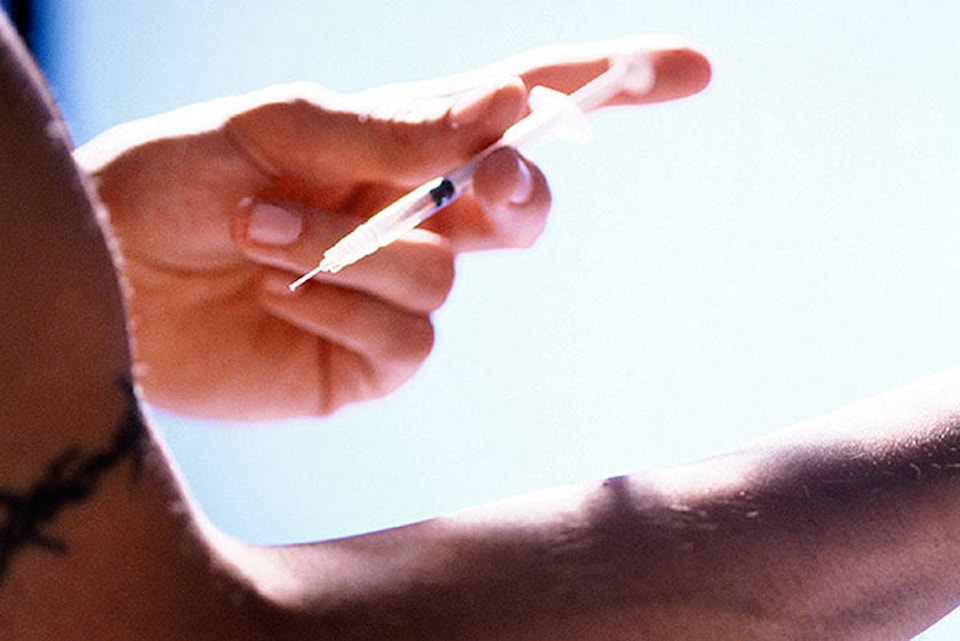Interior Health (IH) says its efforts towards harm reduction in Penticton, and the rest of the region, are “a lot more than just handing out needles.”
Penticton city council heard a presentation on Tuesday regarding the current harm reduction methods being taken by Interior Health to deal with the ongoing drug addictions and opioid use in the city. In the last month, a community group called Project Penticton formed in response to an apparent increase of improperly disposed needles in the city’s public spaces, with one child even allegedly stepping on a used needle in Skaha Lake Park recently.
The city invited IH to make a public presentation at the July 2 council meeting to elaborate on the provincial needle distribution program, which some residents in the community feel should be scrapped given the amount of needles ending up in public parks, streets and other property. According to the presentation, the city currently has seven spaces participating in the program and saw 167,000 needles ordered for the city, and the latest numbers gathered by the BC Centre for Disease Control show 440 people inject drugs in Penticton.
READ MORE: OD prevention sites possible at Canada’s prisons: Correctional Service
Coates said up to five needles are being distributed to one person at time, but opioid users may need to inject multiple times a day so the amount of needles ordered for the city is proportional to this.
The province originally started with a needle exchange program, but switched in 2002 because it put up access barriers and evidence showed that having an exchange program over a distribution program doesn’t have an impact over the number of sharps being properly disposed of.
“Harm reduction is a whole lot more than just handing out needles. It’s programs and policies, practices, a philosophy that looks at aiming to reduce the negative consequences that are associated with behaviours that we consider to be high risk,” said Lesley Coates, regional harm reduction coordinator, during the meeting. “With the ultimate goal of increasing safety, minimizing injury, death and disease. And there is a solid evidence base behind harm reduction, we’re very successful at doing those things.
“I encourage you to think of harm reduction broadly, and ask yourself why we accept some measures of harm reduction more than others.”
According to Coates, the health authority’s job is to ensure people have access to sterile supplies and the purpose of the provincial program is to reduce the needle sharing between people who use drugs. She explained this reduces the spread of HIV, Hepatitis C and other illnesses.
READ MORE: City of Penticton to discuss needle disposal with Interior Health
“The provincial needle distribution program is actually cost-effective because it reduces the provincial health care costs and demand for treating these illnesses, which is much more expensive than preventing them,” said Coates. “It’s also an entry point for people to other services such as housing, health care, treatment. And for many people who use the needle distribution programs, it’s their first point of contact with a health care professional, ever. And it’s a trusting and safe contact that can make all the difference in the world.”
Coates said harm reduction is not just related to substance use, using the implementation of helmet laws for motorcycle riders as an example of how we keep people safe during a high risk activity. Dr. Karin Goodison, a medical health officer with IH, said that the organization implements three key intervention measures when it comes to substance use: distribution of naloxone kits, hosting overdose prevention sites or safe injection sites and treatment for opioid use disorder.
“Over 39,000 naxolone kits have been used to reverse an overdose in British Columbia, and the number is probably higher than that. Overdose prevention sites provide people with a safe place to use a substance and to be responded to in case of an overdose,” said Coates. “No one has ever died in a supervised consumption or overdose prevention site.”
Coun. Judy Sentes questioned whether retractable needles could work instead to mitigate risk to the public when they are improperly disposed of. Dr. Goodison the problem is that you can only inject the full amount in the syringe, rather than the small test dose IH recommends to determine if the drug is high toxicity.
Coun. Campbell Watt said that while Dr. Goodison pointed out that the chances of getting sick from stepping on a discarded needle in the city are “very low” that “it’s not good enough” because it’s being caused by an illegal activity and the sharps of being disposed of properly.
Goodison said IH sees it as a collaborative effort to handle the problem, as it is not solely the responsibility for the city nor the organization. She added that the organization plans to work with SD67 to help with needle clean ups at schools, and on a public campaign to better educate the public and those who use opioids.
To report a typo, email: editor@pentictonwesternnews.com.
<>Jordyn Thomson | Reporter
JordynThomson
Send Jordyn Thomson an email.
Like the Western News on Facebook.
Follow us on Twitter.
